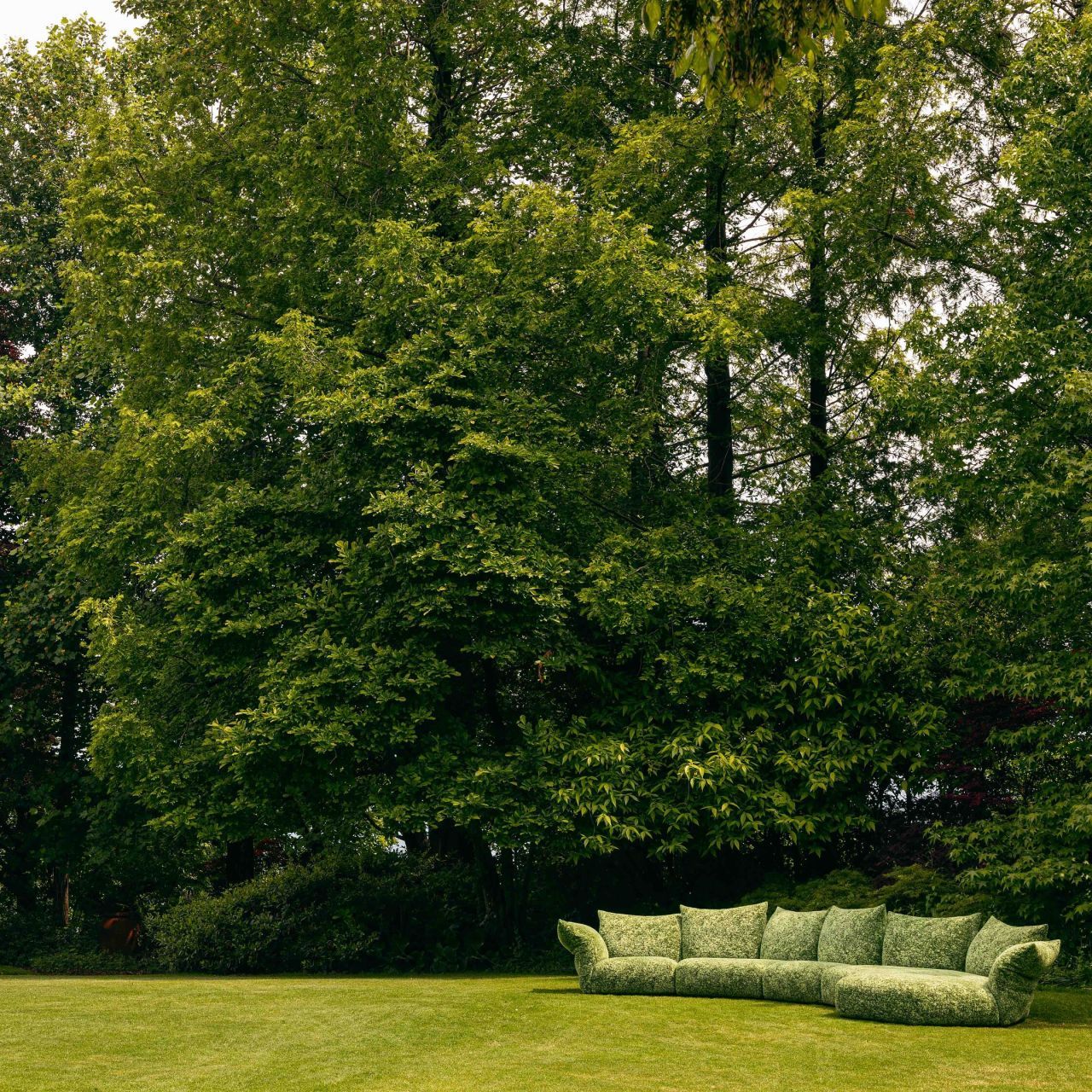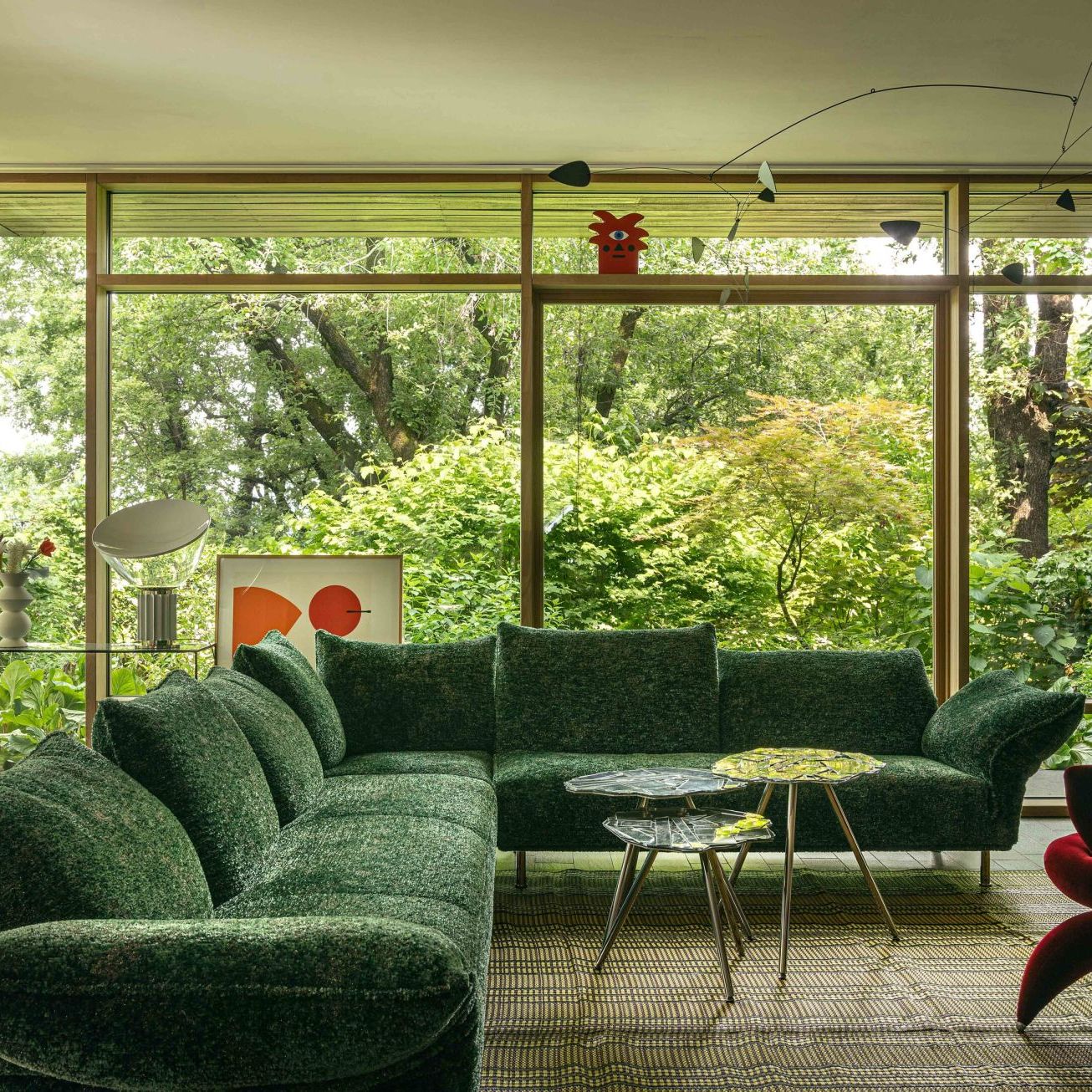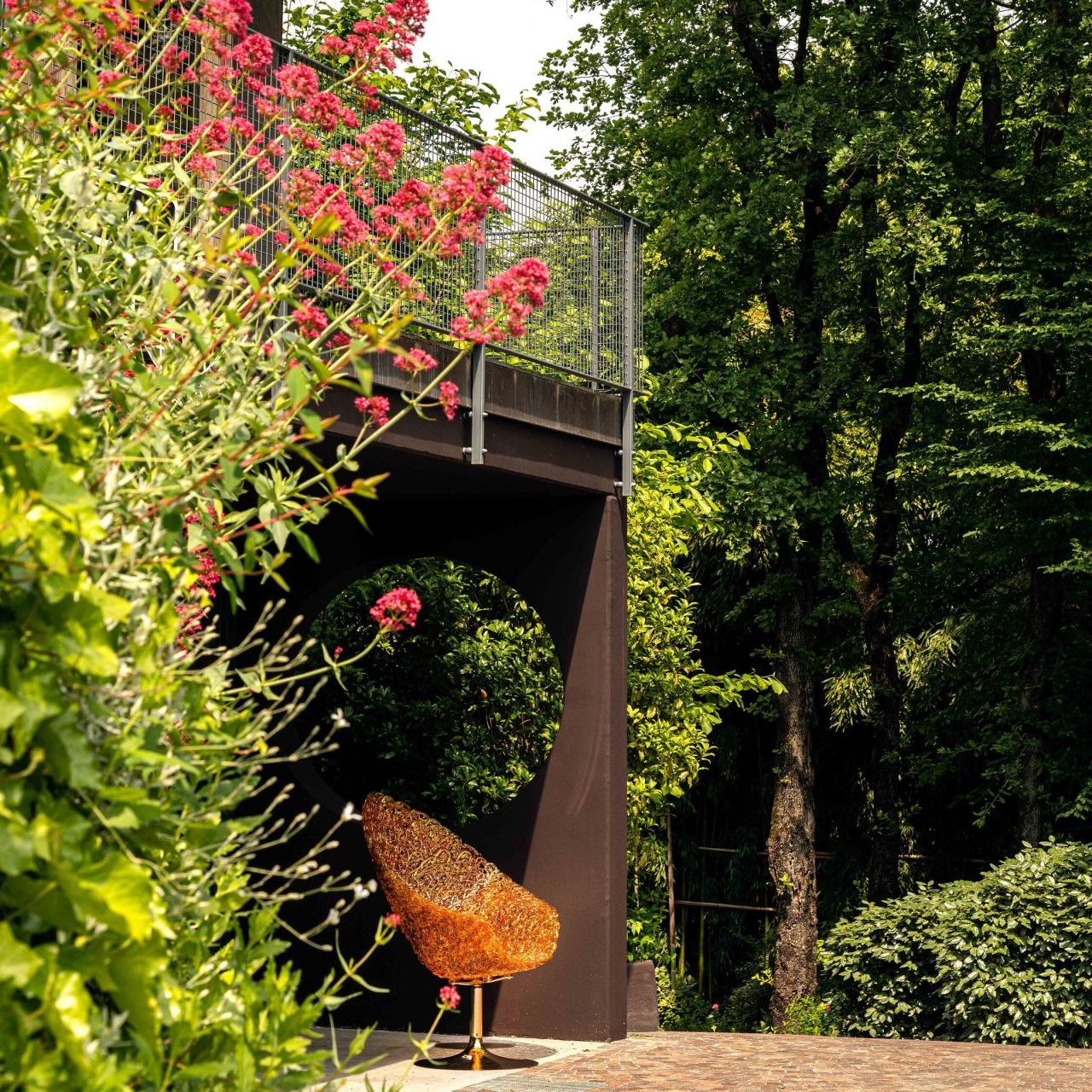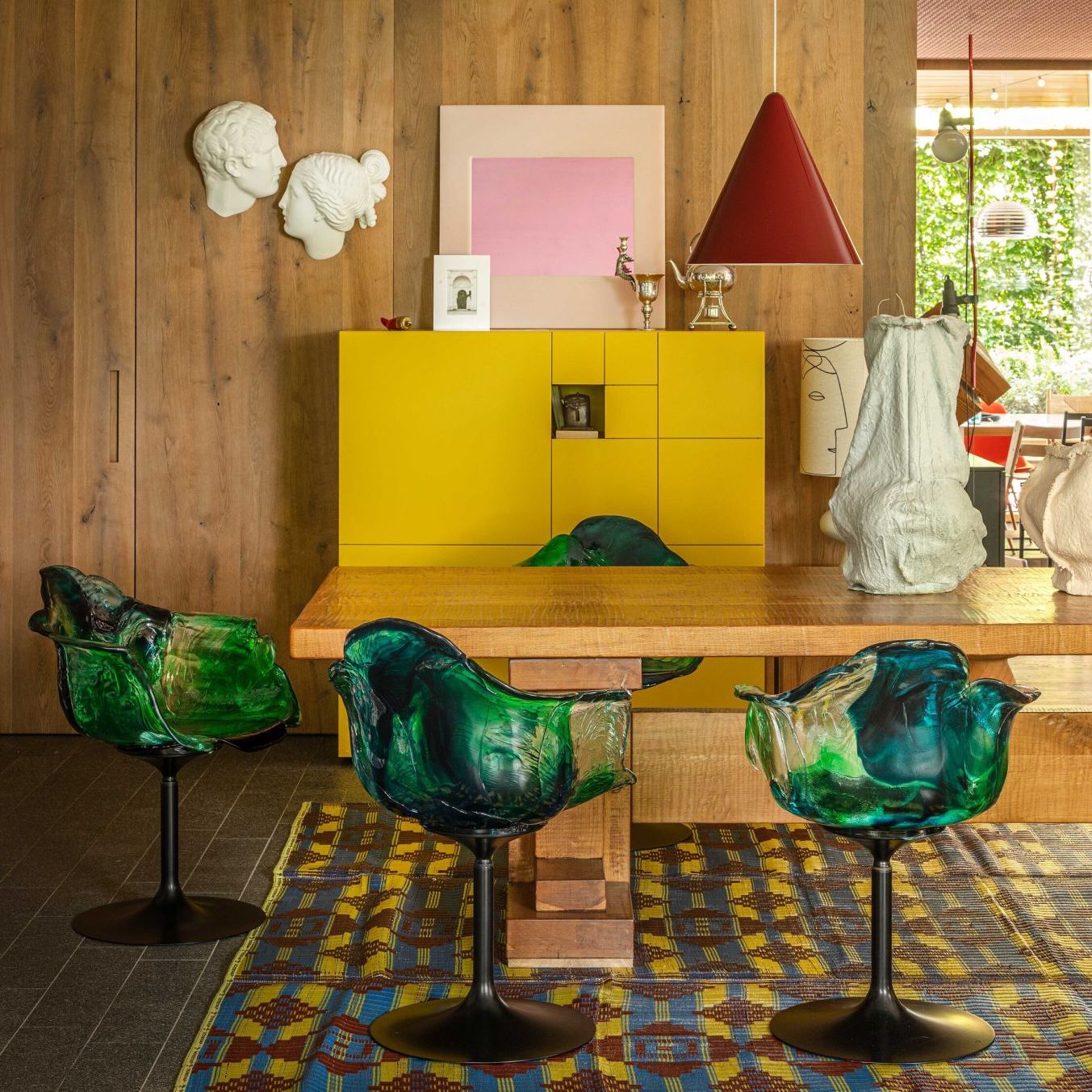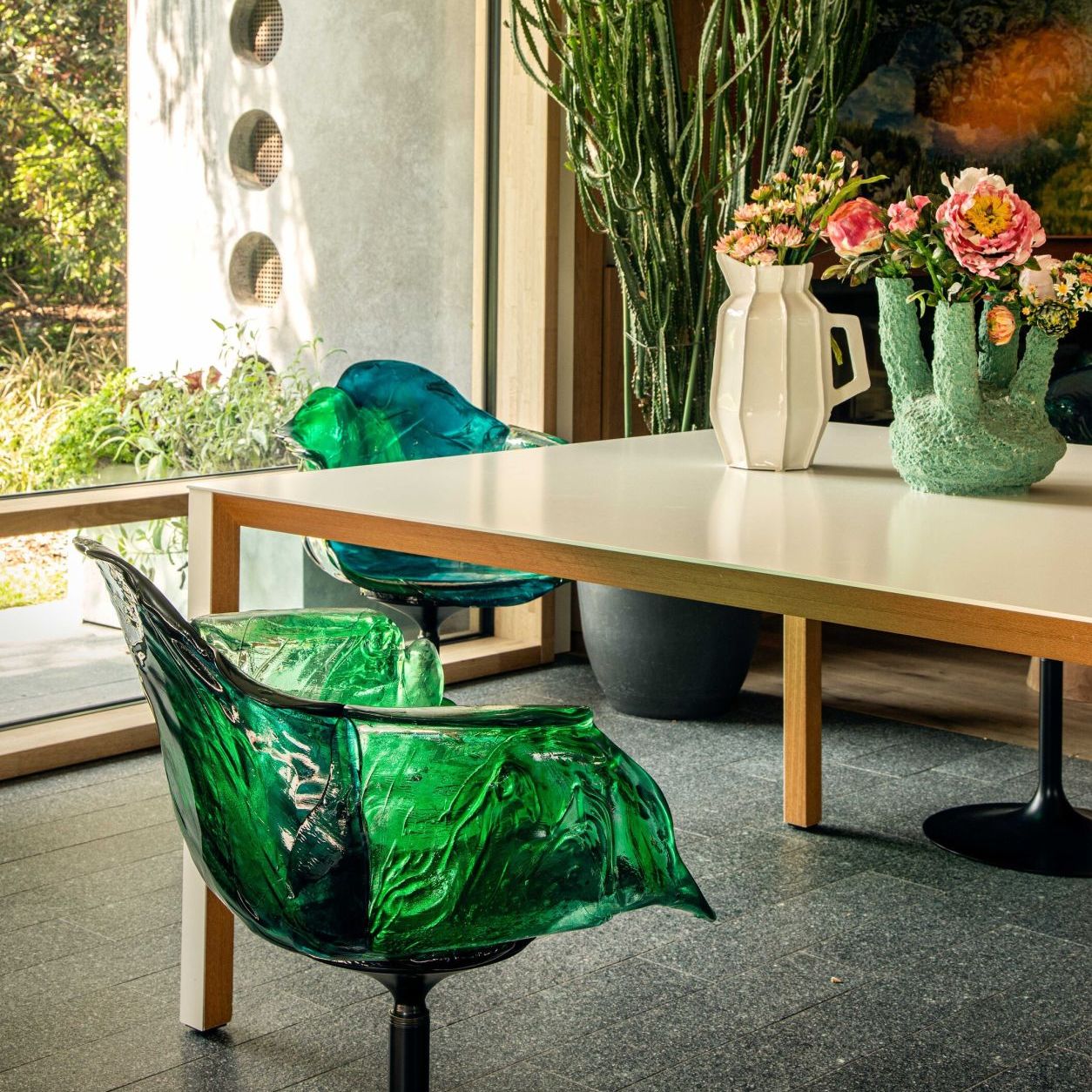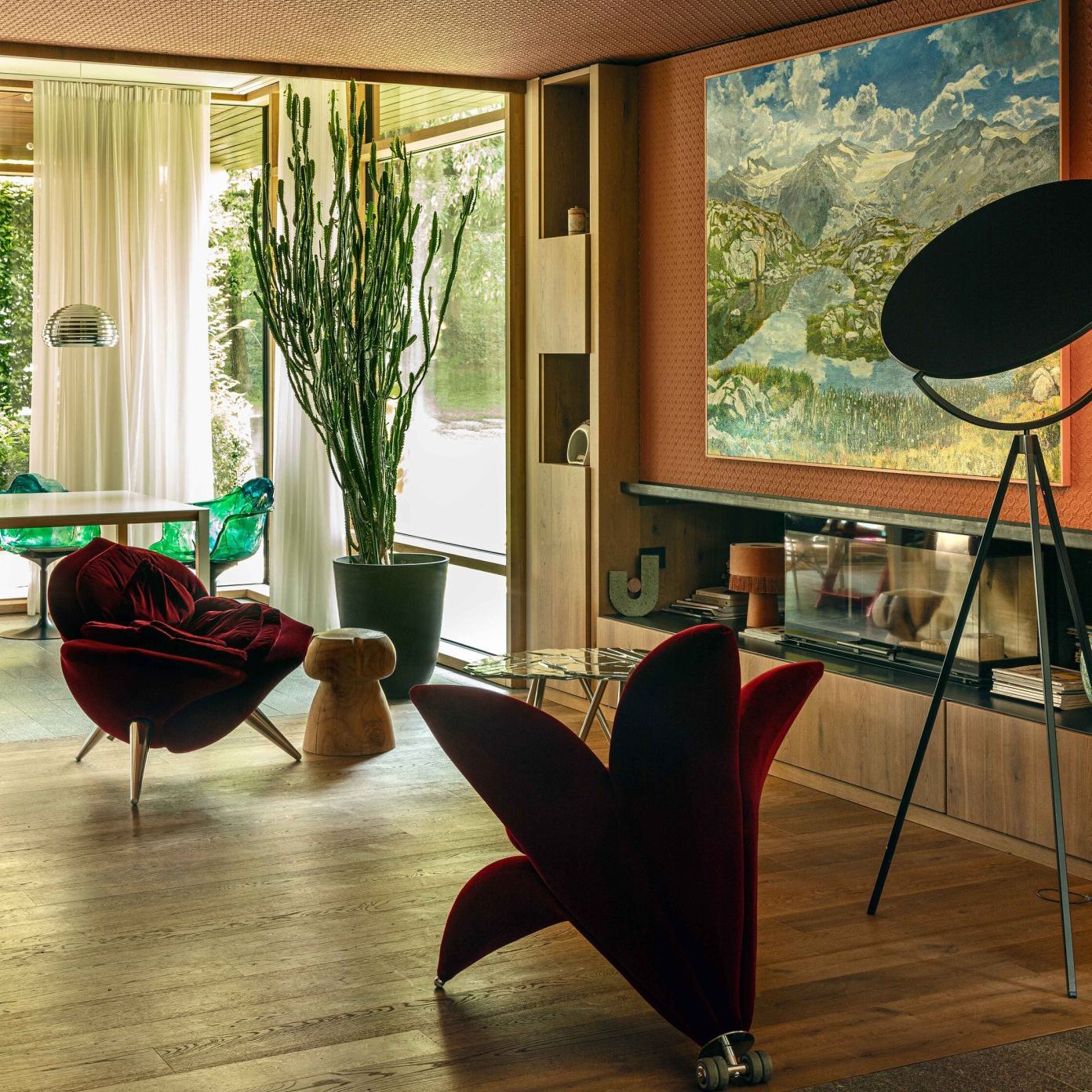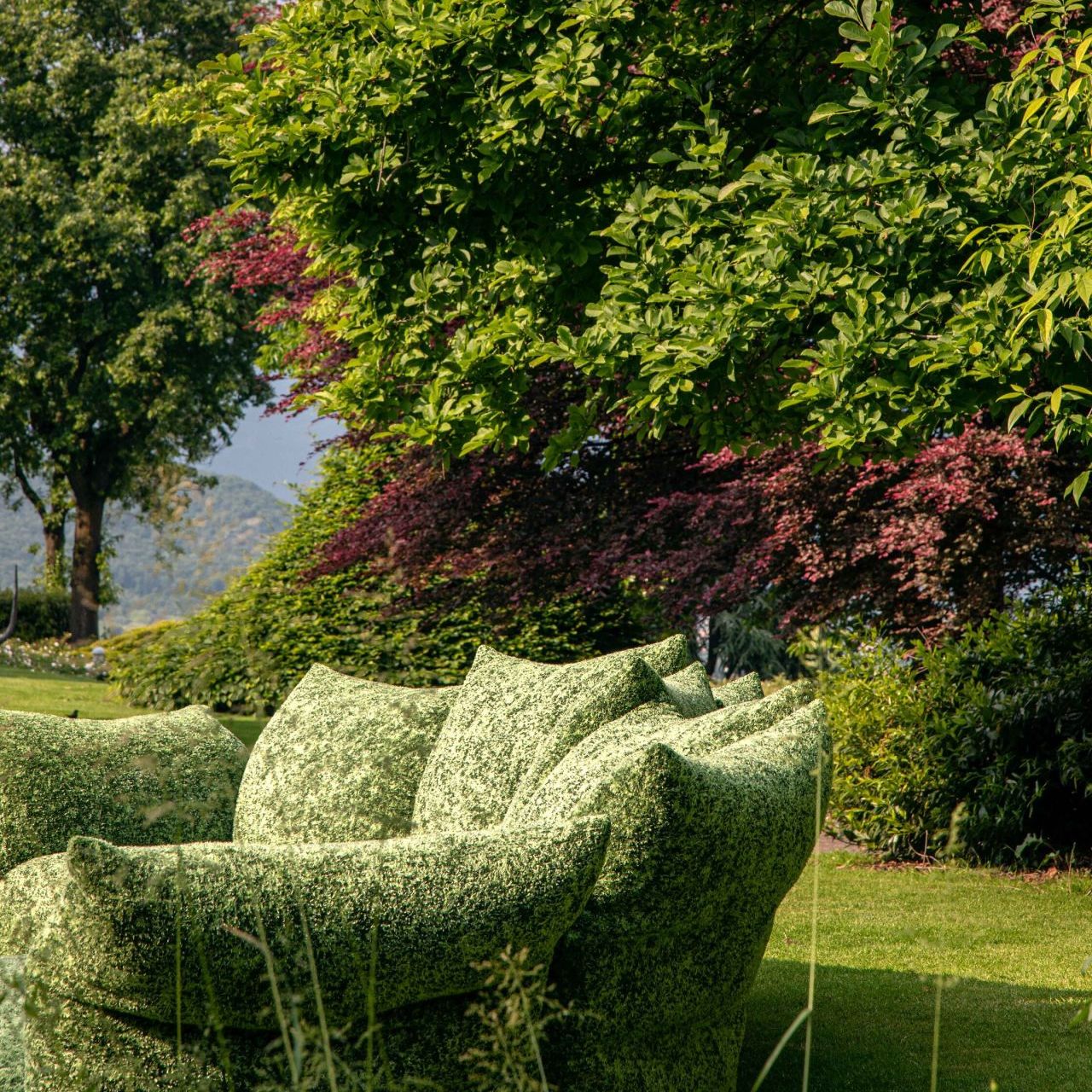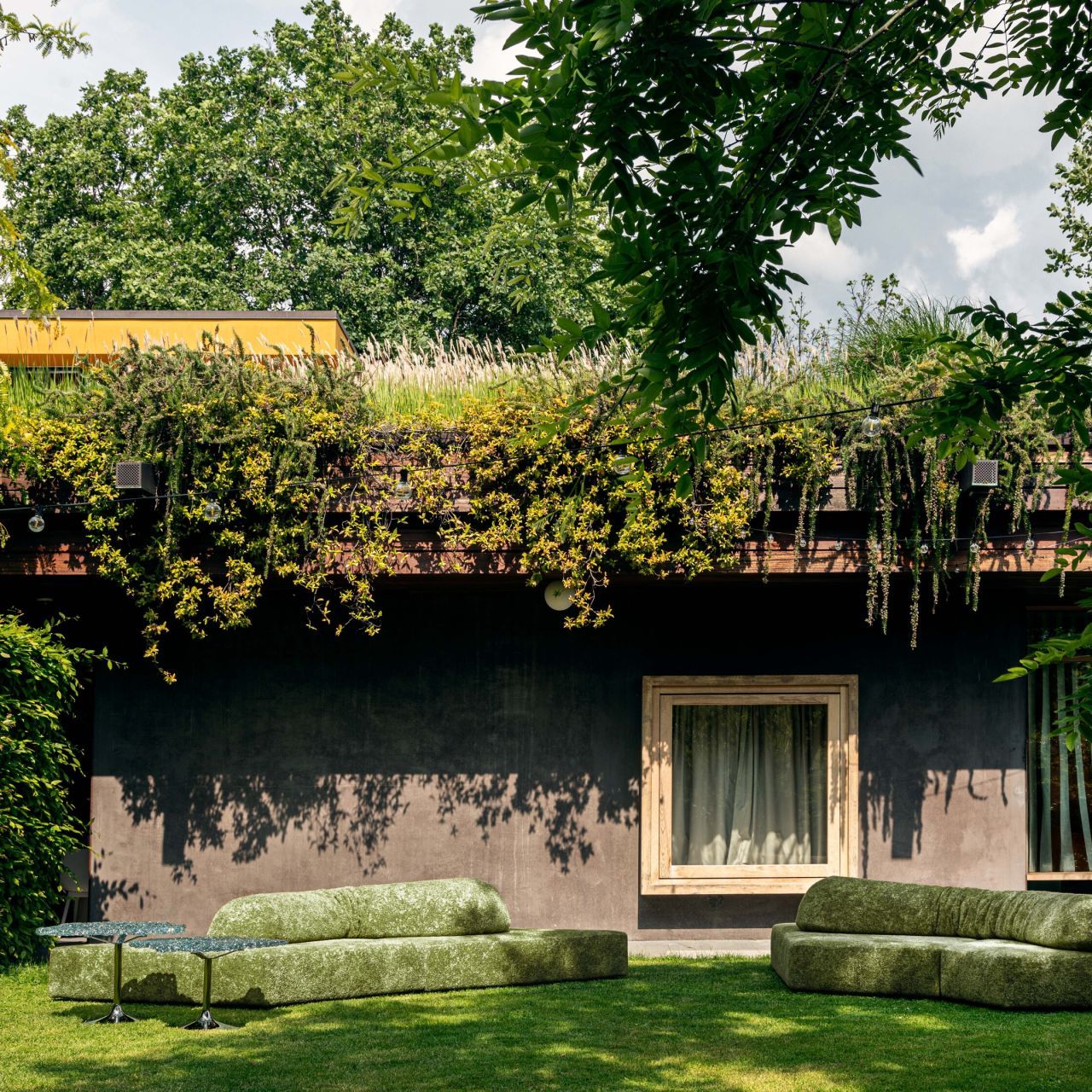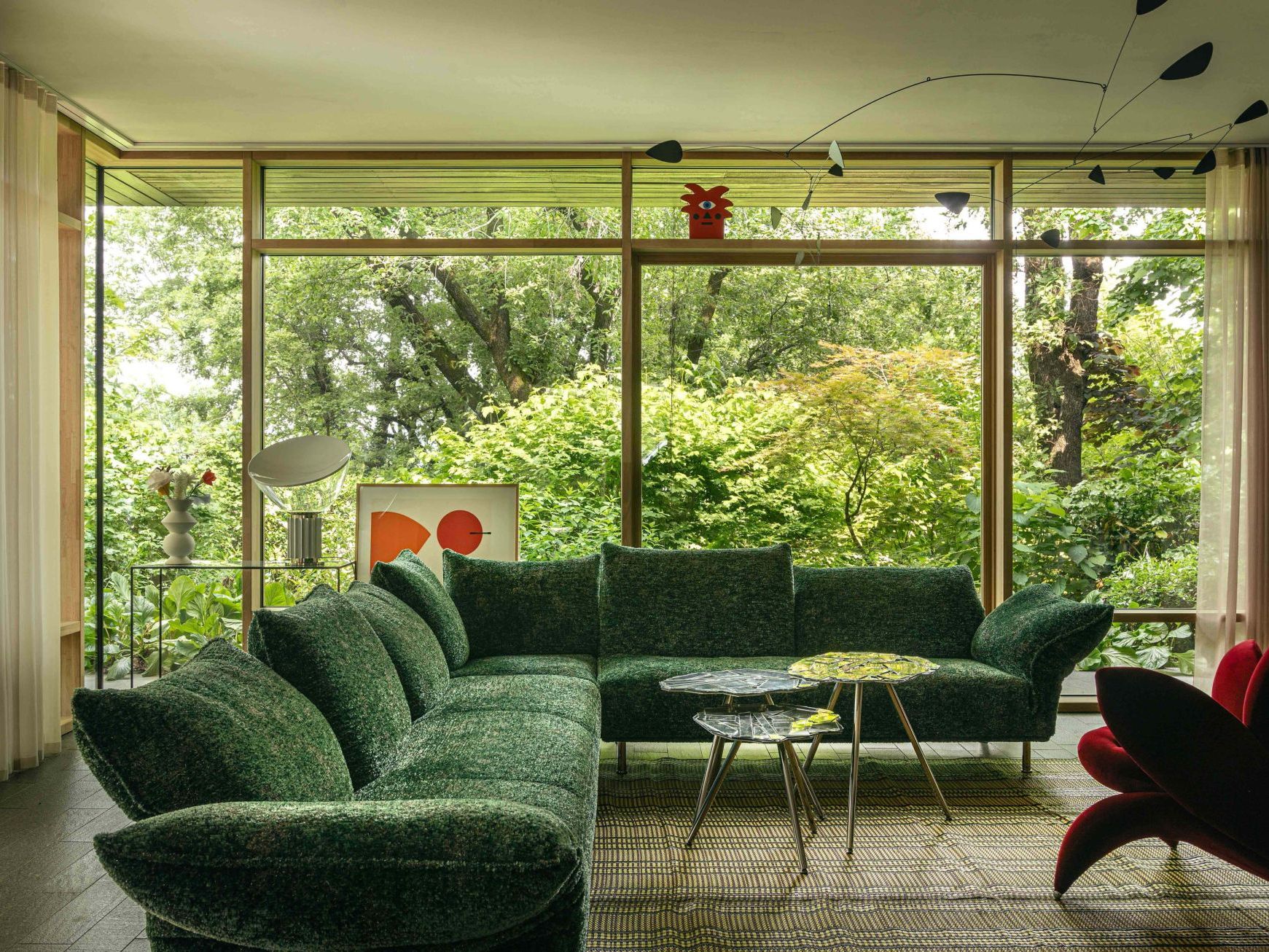
September 2025
Living with Nature and in it
A villa in Franciacorta overlooking Lake Iseo among vineyards, park and woods
In the heart of Franciacorta, among the vineyards of the family estate, Valentina Moretti has designed her home as a radical gesture of conciliation with nature. This is not only about architecture, but a way of living and thinking. It is a house that does not try to dominate the landscape, but to become landscape itself, open to the light, sounds, and seasons. It is home as a living organism, in which every element has been conceived to last, age and transform as happens in nature. This work makes a strong point of low definition, considered not as a lack but as an essential space of "emptiness" left to the imagination and transformation. In effect this is not the usual highly polished architecture, but the translation of an idea of home into four volumes of brutalist flavour, where structure and decorative apparatus coincide, lying between woods to the north and a garden to the south, and connected to each other by a series of "interspaces". Here the relation between architecture, furnishings and nature is fluid, continuously moving, alive: a micro-ecosystem similar to that discussed by Luca Molinari in his book Stanze. Abitare il desiderio. Quoting Gio Ponti, Molinari writes of rooms as being “worlds”, a "portrait of those who inhabit and continually modify them over the arc of the seasons and their own lives, and also because they tell the story of what we have taken from the world and how we have modified it”. Molinari invites us to interrogate each room, to enter into contact with the subtlest nuances of our existence, that leave us with a feeling of completeness and let us observe the world with different eyes. For Molinari the privilege of discovering details that fill us with emotion, to marvel at them, is an exercise in wonder to be cultivated. Every room is made not only of walls and objects, but defined by the more subtle materials of changing light and reacting colours, surface noises and the tactile sensation of every material. Smells, connected with lived in spaces, with animals, with people, contribute to creating the unique atmosphere of each space.
Laura Arrighi: We have carried out the exercise Luca Molinari suggests. Through the models in its collection Edra has interpreted the relation in your home between subtle materials, furniture and space, artifice and nature, with unexpected relations. The effect of the reverberation in the entrance pool is solidified in the garden thanks to the A'mare collection. Lilies and Roses have flowered in the rooms. Ella armchairs, recalling the shape of a flower, and mirrored Brasilia tables have lit up the rooms with a play of light and colour, giving an incredible play of light. Outside, the large garden, veranda and “residual” corners near to the house have become open-air lounges, with sofas that transform the textures of nature into three-dimensional objects.
Valentina Moretti: I love having the house photographed. On these are occasions the inter-spaces – the entrance with the pool, the play area with its beautiful corner window over the vineyards, the corridor and the veranda – all take on unexpected functions: of small living room, study or think tank. They are being interpreted in a personal way and I get a chance to discover new possibilities myself; for using them, and viewing them, catching glimpses, the lighting, the colours.
Laura Arrighi: The house is a “manifesto” and prototype of the Moretti-MORE construction method, the company you founded with Francesco Matricardi in 2010. It is a model that brings together construction company and design studio: a research laboratory on contemporary inhabiting that combines advanced prefabrication, cost and time control, environmental awareness and a high level of spatial sensitivity.
Valentina Moretti: The house is made of iron, wood, prefabricated concrete and glass. It spreads over three levels on a lot of land of a thousand square metres. There's a basement, a 400 square metre ground floor, and a volume on the roof-terrace that recalls the idea of Le Corbusier's Cabanon. This configuration, with the load-bearing frame only around the perimeter, allows for an open and easily redesigned plan. The distribution of spaces is organised like a comb. There are four main volumes, four "trees" accommodating more intimate functions, and the spaces between them become places of relation, constantly open to dialogue with the outside.
Laura Arrighi: What does it mean to design a flexible space?
Valentina Moretti: It means avoiding rigid functions. I have three children, but one day, if they go and live somewhere else I can completely reorganize these spaces, create an Atelier for workshops and events, or a bed and breakfast.
Laura Arrighi: The house is in raw concrete and a dark anthracite pigment paste has been used to blend with tree trunks, the solid untreated wood, and the porphyry that continues without interruption between inside and out. MORE selects “environmentally conscious” materials and focuses on beauty that has no fear of time.
Valentina Moretti: I believe deeply that material should recount the passing of time. Beauty isn't in perfection but in the traces and memories each material leaves. In an era where everything has a tendency to look fake and shiny, I believe authenticity is more important.
Laura Arrighi: Nature is often linked to the idea of a calming reassuring green with a purely decorative function. Instead recent research has shown that cultural, aesthetic and ethical canons are changing our imaginaries in this area. Untamed nature, wild and dissident, is taking up more and more space in our anthropized territories today. The paradigms of a new domestic landscape, that this house appears to consider, are moving towards a logic of inclusion, to an allocentric vision in which homes have been rethought as buffer zones, delineating new contacts with what is “outside” and amplifying our sense of threshold. What role does nature have in your project?
Valentina Moretti: A fundamental role. The house was studied with the idea of having an integrated visual impact. We are in my parents' garden, and there used to be a vegetable garden where the house now stands. The garden is still very controlled but the house overlooks the woods on one side. I wanted the trees to be close, on top of us even. The branches create shade and the house cools naturally in the summer: in the winter the leaves fall and light comes in. The relationship is direct, almost physical. We have looked for horizontality with a large green roof containing grasses that self-manage without needing much maintenance. A small tree has grown there that I didn't plant. The roof extends out from volumes of the house and envelops it. Symbolically, the idea is of sleeping under roots. This unpredictability that in some ways has "infested" us, that wasn't intentional, fascinates me. Greenery is an integral part of the architecture here; it protects, it insulates, it tells a story.
Laura Arrighi: Sound, light, silence. Is there a natural element you feel yours?
Valentina Moretti: Definitely sound, which is incredibly powerful here. Sometimes I forget it, but when I hear a video that has been made in the house I'm amazed at the birds, the rustling, the wind. I'm fascinated by the “scary” sound of rain beating down in a storm. Then there is the silence at night, which is almost absolute. And, of course, the light. Each season and each hour transforms this space. The first thing I see in the morning is my bathroom window which is ninety centimetres square and a living painting of leaves. When autumn comes, the landscape changes every day. It is a way of being in tune with the rhythm of the world.
Laura Arrighi: Let's stay with the light, how do you manage artificial light?
Valentina Moretti: Lighting is fundamental for defining the atmosphere of a space I can't bear spaces that are only lit by spotlights and give you an airport effect, too flat and impersonal. I prefer using table lamps, floor lamps and suspended lamps that create pools of light and completely change the scenario. Light should adapt to the time of day and my activities, and I like that it can change the atmosphere.
Laura Arrighi: You talk about the rhythm of the world, and light that adapts. Can homes educate us in our relations with the “natural”?
Valentina Moretti: A house like this teaches us first and foremost about the cyclical. It shows us nothing is static: nature changes, and the house changes with it. It makes us familiar with the idea that “forever” doesn't exist, that everything changes, even our way of inhabiting a place. Nature teaches us that getting old is not a defect but a normal process. And it invites us to live outside more, to get up, go out, to share. This has an educational impact on children too. They learn that change is part of the game of life.
Laura Arrighi: As far as architecture and the relation with landscape is concerned the direction is clear to me, but regarding the interiors I can't identify a style. Perhaps that isn't what you're looking for.
Valentina Moretti: Choosing furniture, accessories and works of art is often tied to emotional reasons. I don't enjoy rigid styles. Very different pieces coexist in my home, for example a Tyrolean piece of furniture with another modern piece in white metal. Above them is a painting my mother gave me, in a 19th-century frame, but maybe in two months the painting will end up in the guest room and be replaced by a large photograph. My preference is for unique pieces that are also iconic. I choose companies that offer timeless design.
Laura Arrighi: You mentioned technology, and we have talked a lot about nature. MORE stands out because it brings together these different identities, the innovative, the industrial and the technological. But it is also very attentive to environmental sustainability. I am thinking of the Architecture Biennale curated by Carlo Ratti that has just opened in Venice with the title Intelligens. Natural. Artificial. Collective. It is a reflection on the discipline of architecture as a broad field capable of bringing together different forms of intelligence.
Valentina Moretti: I see no contradiction between technology and nature, if technology is used intelligently. MORE also works with historical materials like raw earth, straw and hemp, but without innovation these materials have no duration. Then we have domotics, or home automation, which lets your home understand when to turn off the cooling system, and when to activate the sun screens. Artificial intelligence can be useful when it's used to read data and interpret it in ecological ways. The problem isn't technology, but how we decide to integrate it into our lives.
Laura Arrighi: MORE has cultural ambitions to do with ways of inhabiting. In ALTROVE, the research program you curate, you explore new models, with a particular interest in rural areas, giving value to local communities in sustainable and innovative ways. Can we read this as a reflection on collective intelligence?
Valentina Moretti: The ALTROVE research goes beyond home products, beyond a purely architectural design. It looks for new ways of inhabiting, more responsible, for a more circular future. And for me this means no longer living in private homes but returning to the concept of communities living around the same courtyard, sharing spaces and services.
Laura Arrighi: Is there any of this thinking in your home?
Valentina Moretti: My home is alive, open and welcoming. I like to say there's always a party here. My children say it's too big for five people but at weekends we host friends, relatives and work colleagues. There's always someone cooking, or bringing something, people moving around freely. This house really works when it is inhabited by several people. I've always thought the true beauty of a space lies in its ability to generate relations.
Laura Arrighi: The protagonist in the living room is the Standard sofa by Edra.
Valentina Moretti: I chose it before I had even seen it in person. I was fascinated by the company's history and the quality that sets it apart from every point of view. I also appreciated its technological components, its comfort and ability to "move". It has become part of my way of life and I would never replace it. I might change the colour, but never the sofa. It's like the house, in that it transforms together with me. I chose it because of its fluid shape, invisible technology and ability to adapt. It is an object that never imposes, but accompanies your actions. It is the ideal complement. A piece that has no fear of the passing years, and that integrates and lives with the rhythm of everyday life.





